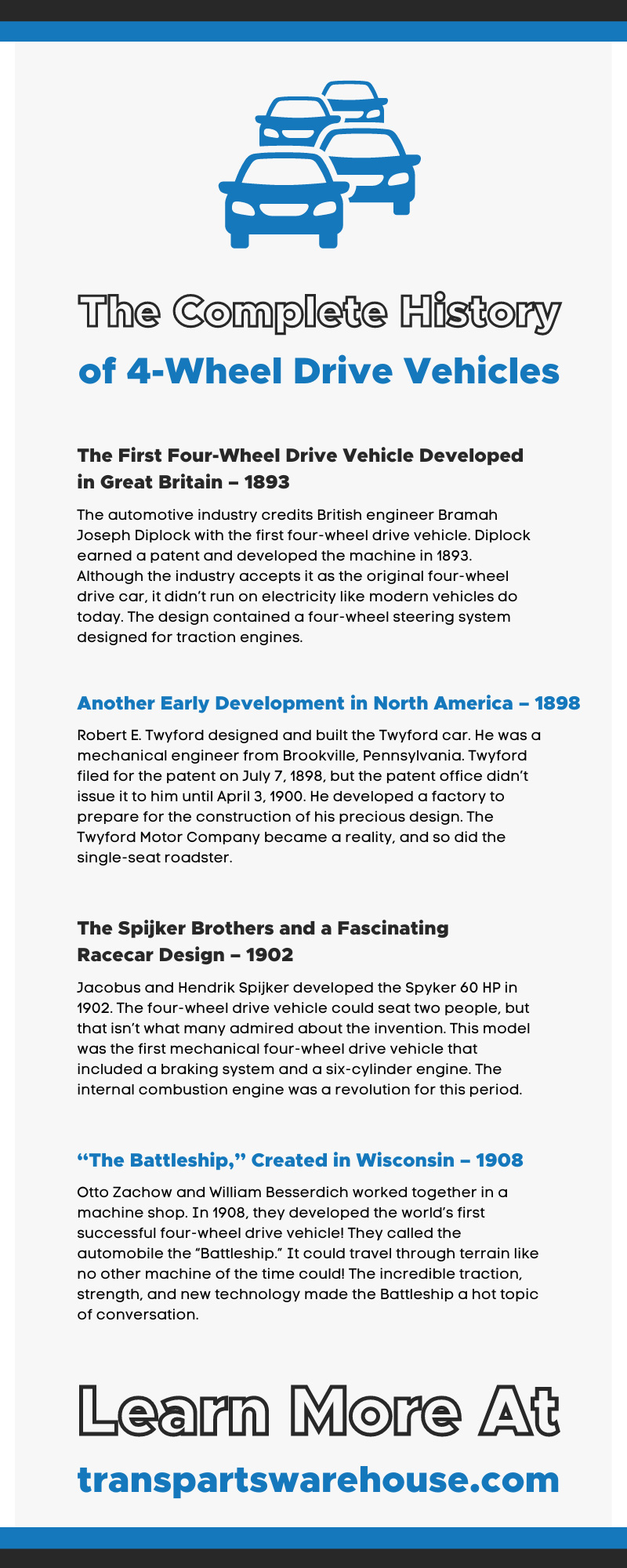
Four-wheel drive vehicles run the modern world. But how did they come into existence?
The truth lies in the history of these incredible machines and the skills of their creators.
It’s important to note that news didn’t travel as quickly throughout the world as it does today. People would have a revelation and become a success in one country, while that same progress followed in another country several years later.
Proper documentation was also a tricky thing. Individuals could invent something and keep it to themselves. Or a person would take someone else’s discovery and pass it off as theirs.
Nevertheless, every individual’s trials and tribulations led to the growth of 4x4’s people know and adore today. Continue reading to understand the complete history of four-wheel drive vehicles.
The Purpose of Four-Wheel Drive Vehicles
The two primary demands were to increase the efficiency of agriculture and war. People wanted a heavy-duty machine that could reliably carry supplies to each location.
The original inventors didn’t foresee the ways these machines would blossom into technologically advanced vehicles. In the past, it was all about making daily activities less laborious.
The First Four-Wheel Drive Vehicle Developed in Great Britain – 1893
The automotive industry credits British engineer Bramah Joseph Diplock with the first four-wheel drive vehicle. Diplock earned a patent and developed the machine in 1893.
Although the industry accepts it as the original four-wheel drive car, it didn’t run on electricity like modern vehicles do today. The design contained a four-wheel steering system designed for traction engines.
A traction engine is a steam-powered tractor designed to move heavy cargo. The mobile steam engine was the source of power for Diplock’s vehicle design.
Another Early Development in North America – 1898
Robert E. Twyford designed and built the Twyford car. He was a mechanical engineer from Brookville, Pennsylvania.
Twyford filed for the patent on July 7, 1898, but the patent office didn’t issue it to him until April 3, 1900. He developed a factory to prepare for the construction of his precious design. The Twyford Motor Company became a reality, and so did the single-seat roadster.
The inspiration was to create a vehicle that could travel through mud, snow, and along hills better than any other vehicle available at the time. The model included power steering and a rigid steering mechanism to prevent additional wheel strain.
The Spijker Brothers and a Fascinating Racecar Design – 1902
Jacobus and Hendrik Spijker developed the Spyker 60 HP in 1902. The four-wheel drive vehicle could seat two people, but that isn’t what many admired about the invention.
This model was the first mechanical four-wheel drive vehicle that included a braking system and a six-cylinder engine. The internal combustion engine was a revolution for this period.
Unlike the popular carriage style of years prior, this vehicle resembles the shape of a modern vehicle. The charming racecar design and mechanical components became an inspiration to other engineers and inventors.
“The Battleship,” Created in Wisconsin – 1908
Otto Zachow and William Besserdich worked together in a machine shop. In 1908, they developed the world’s first successful four-wheel drive vehicle!
They called the automobile the “Battleship.” It could travel through terrain like no other machine of the time could! The incredible traction, strength, and new technology made the Battleship a hot topic of conversation.
The Badger Four-Wheel Drive Auto Company was founded on January 9, 1909, in Clintonville, Wisconsin, as a result of the creation of the Battleship. The three founders include Otto Zachow, William Besserdich, and Walter Olen.
Zachow and Besserdich desired a patent for a ball and socket steering joint and a gearbox called the power-applying mechanism. The steering joint would transfer power to each wheel of an automobile, while the gearbox splits the engine’s power between the front and rear axles.
The men decided to seek help from attorney Walter Olen for the patent. His support led to him becoming the company’s first president. They changed the company name to the Four-Wheel Drive Auto Company on September 24, 1910.
In 1911, the company built a massive two-ton truck that attracted the interest of the U.S. Army. They developed other designs during this time frame, but they weren’t as successful. The U.S. Army’s support for battle-based trucks altered the direction of the FWD company.
Shockingly, North American troops did not utilize the trucks the FWD company designed for war during World War II. The vehicles were sent overseas to North America’s allies, Great Britain, Canada, and the Soviet Union. FWD greatly contributed to the success of the war with its incredible automotive resources.
World Wars and Automotive Mass Production
War used to move slowly. It took weeks or months for troops to travel to each battleground on foot or horse-drawn carriages. World War I developed a need for reliable vehicles that could carry a wide range of supplies and move troops from one destination to another at a quick pace.
Suddenly, four-wheel drive vehicles were mass-produced to traverse battlefields. The military vehicles were basic designs made for off-roading and storing essential equipment. They couldn’t travel incredibly fast, but they were efficient at their job.
The technology of military four-wheel drive trucks made its way across the world. By the end of World War I, automobiles were an ever-present piece of combat.
Creating a Modern Purpose for 4x4 Cars
Jeep is an immensely popular brand today, adored for its off-roading performance and easily recognizable body. But the brand wouldn’t be popular today without its roots in the military.
Willys-Overland Motor Company was the original maker of the Jeep. The vehicles were a military phenomenon.
Gradually, these military vehicles caught the eyes of auto manufacturers. There was immense potential for the commercialization of these vehicles.
The Jeep CJ-2A was introduced in 1945. With a tailgate and a side-mounted spare tire, this model closely resembled the World War II model made by Willys-Overland.
Without the efforts and hardships of the founders of four-wheel drive vehicles, the automotive world wouldn’t look the same today.
Learning about the complete history of four-wheel drive vehicles is all the inspiration you need to start expanding your automotive knowledge. Get up close and personal with your car! Start repairing various components like its transfer case parts. After all, you could become an automotive innovator just like the people before you.


